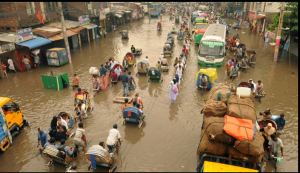Anna Kontorov (UNEP) and Anne Olhoff
Since 2010, United Nations Environment Programme (UNEP) has produced annual Emissions Gap Reports. These reports have supported the UN Framework Convention on Climate Change (UNFCCC) negotiations by providing an assessment of the gap between ambition and reality in the quest to bring emissions levels down. Over the past two years there have been frequent requests from Parties and organisations for a complementary report to be produced on adaptation gaps. The first global UNEP Adaptation Gap Report, launched on 5 December 2014 at the UNFCCC COP20 in Lima, is a response to these calls.
Adaptation challenges require global actionAlthough adaptation is often a response to specific climate risks at a given time and in a given context, the preliminary analysis in the Adaptation Gap Report highlights that adaptation challenges require global action. Adopting a strategic global framework for adaptation, with clear goals and targets, would help set the direction for, and track progress on, adaptation. It is UNEP’s hope that Parties and organisations will find the adaptation gap approach useful in this context and that the report will serve to support discussions under the UNFCCC, including on adaptation aspects of the 2015 agreement.
A framework for defining adaptation gaps
The adaptation gap can be broadly defined as the difference between actually implemented adaptation and a society set goal, determined largely by needs and preferences, and reflecting resource limitations and competing priorities. The UNEP Adaptation Gap Report provides a simple, conceptual framework for defining and assessing adaptation gaps that can be applied at various scales (global, national, regional, sector, city, or community) and can be measured using a wide range of indicators and metrics.
The framework is used as a basis for preliminary assessment of the gap between adaptation needs and reality. The report focuses on gaps in developing countries in three important areas: finance, technology and knowledge. Other gaps, including in capacity and governance, are equally important to consider, as are the complex interactions between various gaps. The report also points to a number of areas for further action and future analysis. UNEP’s intention is to provide fuller analysis of some of these areas in future reports, starting in 2015 with a report focusing on the adaptation funding gap.
New and additional finance is needed to close the funding gap
The Adaptation Gap Report includes an analysis of existing global, sector and national estimates of the costs of adaptation, and compares these against the levels and trends in public adaptation finance flows. It finds that the costs of adaptation are likely to be at least two-to-three times higher than available global estimates, which report adaptation costs in the range of $70 billion to $100 billion. Although there is significant progress in finance flowing into adaptation, the report concludes that there is likely to be a major adaptation funding gap, particularly after 2030, unless new and additional finance for adaptation becomes available. The Green Climate Fund (GCF) could play a key role in bridging this adaptation funding gap. The report similarly points to the importance of further investigating the role and potential of the private sector in adaptation.
Large potential for technology and knowledge to help bridge adaptation gaps
The report finds that there is significant scope for bridging adaptation gaps by accelerating the diffusion of existing technologies for adaptation, and highlights the importance of focusing on technologies that contribute to a range of development objectives beyond climate benefits. Similarly, the report illustrates the large scope for using knowledge more efficiently and for tailoring it better to the needs of users, including local farmers, large companies or policy makers.
Mitigation action is crucial for avoiding an insurmountable adaptation gap
The risks and impacts of climate change are expected to increase significantly in coming decades. The size of the emissions gap has crucial implications for the adaptation gap and the levels of adaptation effort that will be required to manage unavoidable climate risks. Many regions, sectors and systems are approaching the limits of human and ecological systems to adapt to these changes. The Adaptation Gap Report serves as a reminder that ambitious and immediate mitigation action is a crucial precondition for avoiding unmanageable climate impacts and an insurmountable future adaptation gap.
(UNEP Adaptation Gap Report – A Preliminary Assessment: http://www.unep.org/climatechange/adaptation/gapreport2014/)




